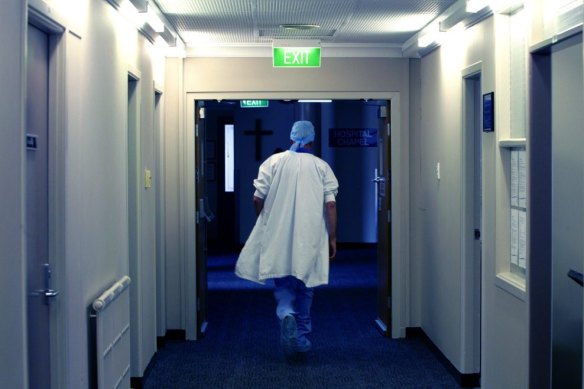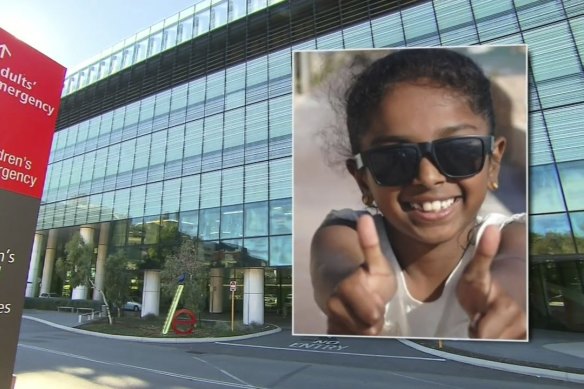This was published 4 years ago
Opinion
Cook praises WA’s health system, but doctors and nurses tell of ‘fatigued, worn out’ staff
Gareth Parker
ColumnistIn trying to figure out what might have happened at Perth Children’s Hospital on Easter Saturday night, an experienced medico shared a chilling observation.
The workforce had been asked by the system to “sprint” for the past four or so years and clinicians are “fatigued, worn out, and have got to the point where they are very tolerant of the misery of others.”

Nurses feel anxious about working for fear they cannot deliver adequate care to their patients.Credit: Nic Walker
The senior clinician, it must be stressed, does not work at PCH and has no direct knowledge of events that led to the death of sunny, intelligent seven-year-old Aishwarya Aswath.
Those matters will be the subject of a 4-6 week “root cause analysis” by the hospital — a formality after any SAC 1 (severity assessment code 1) event, that is one that has or could have had serious or fatal consequences attributed to healthcare provision or a lack thereof.
The death will also be investigated by the coroner.
Health Minister Roger Cook expressed his sympathy for the family while shielding himself and his government from blame.
The parents went to our premier children’s hospital in their hour of need and were ignored.
In his formulation, it is the government’s responsibility to provide resources to WA’s public hospitals, and it is up to hospital boards and managers to apply those resources to clinical need.
Cook now acknowledges the system is significantly stressed — describing a surge in post-COVID demand for services in both quantity and complexity — but insists it is operating well.
He doggedly points to four-hour rule performance and elective surgery wait times that rank among national leaders of the Australian states, but it is at odds with the increasing number of stories told by clinicians and patients.
The AMA and Australian Nursing Federation have never been shy about asserting crisis in the name of more resourcing, but the minister cannot hide from ambulance ramping statistics that have shattered all records on his watch over the past 10 months.
As we have been pointing out since last August, that is a canary in the coalmine marker that points to blockages in the system, initially rejected by Cook and now acknowledged with a plan to bring 300 new beds onstream over the coming years.
Let’s give the call, though, to the parents of little Aishwarya.

Aishwarya deteriorated in the emergency department of the Perth Children’s Hospital.Credit: Nine News Perth
In a heartbreaking interview with Nine News aired on Monday night, her father Aswath Chavittupara was in obvious shock, visibly shaking and barely able to get the words out between heaving sobs.
Those words, though, struck with thunderbolt clarity.
“I lost my child. This shouldn’t happen to any other child in this country,” he said.
Her mother, Prasitha Sasidharan, knew something was deeply wrong with her second-eldest of four children.
She had been running a fever for over 24 hours and her condition was deteriorating in the emergency room before her very eyes, her hands going cold and with white spots starting to form in her eyes.
“I went to the reception maybe four or five times and I asked them to have a look at her,” Ms Sasidharan said.
“They were actually neglecting us. We pleaded with them to have a look. They didn’t think it was an emergency.”
Whether more timely treatment would have saved Aishwarya is not known. Doctors say her symptoms are consistent with a likely diagnosis of sepsis, a rarity and something that is often very difficult to treat.
She was assessed at triage as a category 4 patient (of five categories where 1 is the most clinically urgent and 5 is the least).
“It may be that the triaging was wrong. It may be that the triaging was correct, but then other events took place. I don’t want people to get ahead of themselves in relation to this,” Cook said.
Child and Adolescent Health Service chair Debbie Karasinski confirmed four of 18 doctors who would ordinarily be rostered on were absent, off sick, but had little further useful to say, with media reporting filling some of the gaps.
A parent who was also at PCH on Saturday evening with her own child told WAtoday Aishwarya was the “sickest child in the ED” but didn’t get the attention she deserved.

Aishwarya Aswath’s parents say they waited for two hours before she was treated.Credit: Nine News Perth
Clinicians were instead occupied with a violent teenager.
A family friend told The West Australian that as Aishwarya’s parents continued to plead for further attention, they were told that her suddenly cloudy eyes were normal and something not to worry about; after two hours waiting she died within 15 minutes of being seen by a doctor.
Could these be the sort of judgments made by a fatigued, strung out, down-on-manpower clinical staff that have seen too much misery of late?
ANF secretary Mark Olson produced correspondence from a PCH ED nurse from last month expressing “grave concerns regarding the staffing levels and safety within our department”.
“There have been several incidents resulting in significant harm to patients in these past few months, and having had discussions with my colleagues, many of them now feel anxious about working in the department knowing they cannot deliver adequate care to all of their patients,” the nurse wrote.
Yesterday, the minister insisted the system was performing well under significant demand pressure. He described hospital care as a “partnership” between clinicians, parents and their children.
The point is that the parents did everything right. That partnership failed. They went to our premier children’s hospital in their hour of need and were ignored.
Now inquiries are ordered to find out how and why.